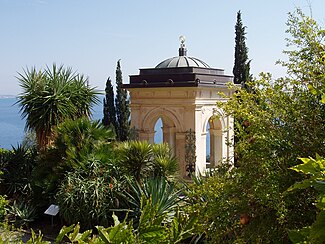Giardini Botanici Hanbury
| Giardini Botanici Hanbury | |
|---|---|
 |
|
| Type | Botanical |
| Location | Ventimiglia, Italy |
| Area | 18 hectares (44 acres) |
| Opened | 1867 |
| Operated by | University of Genoa |
| Website | giardinihanbury |
The Giardini Botanici Hanbury (18 hectares), also known as Villa Hanbury, are major botanical gardens operated by the University of Genoa. They are located at Corso Montecarlo 43, Mortola Inferiore, several km west of Ventimiglia, Italy.
The gardens were established by Sir Thomas Hanbury on a small, steep peninsula jutting southwards from an altitude of 103 meters down into the Mediterranean Sea. He purchased the extant Palazzo Orengo property in 1867, and over decades created the garden with the aid of pharmacologist Daniel Hanbury (his brother), the botanist and landscape designer Ludwig Winter and scientists including Gustav Cronemayer, Kurt Dinter, and Alwin Berger. In 1912 the Hortus Mortolensis, the catalogue of the garden, contained 5800 species, although the garden itself had more. Hanbury died in 1907, but energetic plantings and improvements resumed after World War I under the direction of his daughter-in-law Lady Dorothy Hanbury.
The gardens were severely damaged in World War II, when they became a no-man's land and in 1960 Lady Hanbury sold them to the State of Italy. Initially its care was entrusted to the International Institute of Ligurian Studies but when they withdrew for lack of adequate funds in 1983 responsibility was passed to the University of Genoa. Restoration has been gradually proceeding since 1987 and it was declared a nature preserve in 2000.
On 1 June 2006 the Ministero dei Beni e delle Attività Culturali submitted a proposal for the inclusion of the gardens on the list of UNESCO World Heritage sites.
...
Wikipedia
